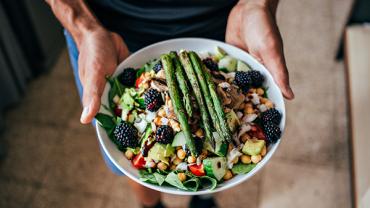
A strict Paleo diet eliminates all grains, legumes, and dairy. Beyond that, it’s “macronutrient agnostic”—meaning, it can be low or high in carbs, and low or high in fat, depending on someone’s goals and preferences. The main premise is to avoid foods that would not have been available to our hunter-gatherer ancestors and to approximate our ancestors’ diet with foods available to us in the modern world. The Primal diet, popularized by author and blogger Mark Sisson, is a bit more generous. It allows for beans and legumes, dairy products, and gluten-free grains, with an emphasis on all of these being whole, unrefined, and unprocessed. Owing to the availability of grain-free bread, quinoa chips, and other items that follow the letter of these ways of eating but not the spirit, however, it’s possible to follow a Paleo or Primal diet yet come up short on critical nutrients. With that in mind, let’s look at ways to optimize nutrient density when following these diets.
Maximizing Nutrient Density
Optimizing nutrient intake on Paleo or Primal—or any other diet, for that matter—involves getting the full spectrum of vitamins, minerals, and essential fats and amino acids. Eating high-quality animal foods, such as beef, lamb, pork, poultry, shellfish, eggs, and dairy products, ensures complete protein intake, and most of these are also loaded with micronutrients. Red meat is an excellent source of B-vitamins, iron, zinc, selenium, and more. Pork and poultry fit this description too, but they’re lower in iron than red meat.
Muscle meat is low in folate, but organ meats—liver, especially—are powerhouses for folate and other B-vitamins, as well as iron, copper, and vitamin A (true vitamin A, not beta-carotene). Organ meats even provide a little bit of vitamin C, although not as much as plant foods. Nose-to-tail cooking, with consumption of organs, gelatinous broths, and meat cooked on the bone, is a way to get collagen and nutrients that are lower in muscle meats.
Regarding intake of the full array of fatty acids, consuming animal foods or, for vegetarians, coconut and olive oils, avocados, nuts and seeds, covers the bases. Grass-finished meats and eggs from hens whose feed is supplemented with flaxseeds or fish meal provide some omega-3 fatty acids, but seafood is really the powerhouse when it comes to EPA and DHA. We typically hear more about EPA and DHA than we do about ALA (alpha-linolenic acid), which is the omega-3 found in plant foods like nuts and seeds, and in very small quantities in leafy greens, but this doesn’t mean ALA is meaningless in human nutrition. ALA can be converted to EPA and then DHA, but ALA has some health benefits of its own, including possible reduction of risk for coronary heart disease. (The conversion of ALA to EPA and DHA is not efficient in many people, so strict vegetarians who don’t consume seafood may wish to supplement with algae-based omega-3s.)
More Than Just Meat
Paleo and Primal diets are often thought of as meat-heavy (and caricatures of burly cavemen chowing down on Flintstone-style steaks only fuel this myth), but the Primal food pyramid has vegetables at its base. There’s no need to avoid generous helpings of vegetables on Paleo and Primal diets, and fruits are allowed as well, with total carbohydrate intake tailored to individual sensitivity.
Plant foods provide fiber and add to the overall vitamin and mineral content of Paleo and Primal diets, especially with regard to nutrients that are much lower in animal foods, such as potassium, magnesium, and vitamin C. Nuts, seeds, and beans are great sources of minerals, but these may be bound by various antinutritional factors such as phytic acid, which limit their bioavailability. Traditional preparation methods, such as soaking, sprouting, and fermentation, have been shown to reduce the mineral-binding effects of phytic acid, so those who follow a Primal diet as opposed to strict Paleo may want to take extra care to prepare beans and grains with one of these strategies.
Fermentation isn’t just for foods high in phytate. Traditional peoples all over the world consumed fermented foods—kimchi in Korea, sauerkraut in Eastern Europe, curtido in Central America, yogurt in Scandinavia and the Balkans. Fermented vegetables and dairy products provide probiotics to support the immune system and healthy digestive function.
Herbs and spices can jazz up animal and plant foods alike while also providing valuable phytonutrients with broad health benefits, such as curcumin (from turmeric). Rosemary and ginger contain anti-inflammatory compounds, and let’s not forget the antimicrobial effects of compounds in garlic and the surprising anti-depressant properties of saffron. Consuming a wide variety of different colored vegetables and fruits is another way to diversify intake of phytochemicals, such as the anthocyanins in red, blue, and purple plants (e.g., red onions, darkly colored berries), lutein, zeaxanthin and carotenoids in orange, yellow, and green plants, lycopene in tomatoes, and sulforaphane precursors in broccoli and other cruciferous vegetables.
Before the advent of supermarkets, refrigerators, and chest freezers, our healthy, robust ancestors didn’t have the option of eating the same thing every day for months or even years at a time. Their diets included a wide variety of animal and plant foods that changed seasonally based on what was available in their surroundings. To maximize the nutrient content of a Paleo or Primal diet, it may be best to mimic this strategy while emphasizing foods and cooking methods that maximize overall nutrient density.